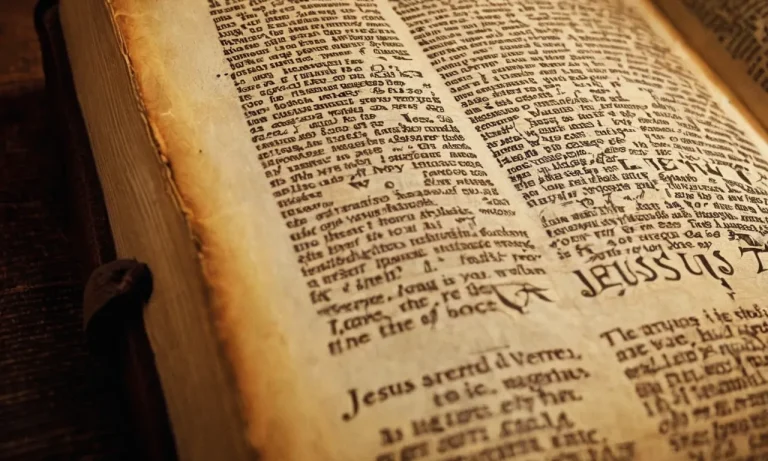What Does Jesus Look Like In Heaven?
The question of what Jesus looks like in heaven has fascinated Christians for centuries. Though the Bible does not provide a detailed physical description, it does offer some intriguing clues about Christ’s heavenly appearance and form.
If you’re short on time, here’s a quick answer to your question: Jesus likely has a glorified, spiritual body in heaven that reflects both his divine nature and his identity as a human being who lived on earth.
Biblical Descriptions of Heavenly Beings
Angels
The Bible contains numerous references to angels, describing them as spiritual beings created by God to serve Him and act as messengers. Angels are mentioned nearly 300 times in Scripture. They are described as having human-like attributes, such as faces, voices, feet, and hands.
Though lacking physical bodies, angels can take on human form or appearance (Genesis 18:2). Angels are depicted as winged creatures (Isaiah 6:2) who can fly swiftly between heaven and earth. Their appearance is dazzling, radiating the glory of God (Matthew 28:3).
The Bible emphasizes the power of angels, capable of delivering God’s judgments and wielding control over nature. Yet they remain subordinate to God, created to serve His purposes (Psalm 103:20).
Glorified Bodies of Believers
The Bible teaches that when believers die, their spirit goes to be with God in heaven while their body remains on earth. At Christ’s return, there will be a bodily resurrection – the spirit will be reunited with a resurrected, glorified body (1 Corinthians 15:35-49).
Christ Himself was resurrected bodily, but His resurrection body had new abilities and appeared differently. The same will be true for believers. Their new bodies will be imperishable, glorious, powerful, and spiritual (1 Corinthians 15:42-44).
They will no longer be hampered by sickness, pain, tiredness, or death. Believers will have literal physical bodies, recognizable to their identity, but these bodies will be perfect vessels suited to live fully in the presence of God.
Visions of Christ
Throughout Scripture, visions of heavenly beings often involve descriptions of overwhelming light, rainbow colors, flashes like lightning, glowing jewels, and brilliance beyond earthly compare. The prophet Ezekiel witnessed God’s glory surrounded by radiant light and a rainbow (Ezekiel 1:26-28).
Daniel saw a vision of the Ancient of Days on a throne of flames with burning fiery wheels (Daniel 7:9-10). When Christ was transfigured on the mountain, Matthew 17:2 says “His face shone like the sun, and His clothes became as white as the light.”
Revelation describes Christ’s face shining “like the sun shining in full strength” (Revelation 1:16). The light, colors, and glory emphasize the divine nature of these heavenly beings and the supernatural wonder of God’s presence.
Christ’s Divine Nature
Pre-Existence
The Bible teaches that Jesus existed with God the Father before his earthly incarnation. Several verses indicate that Jesus was present at the creation of the world. John 1:1 states, “In the beginning was the Word, and the Word was with God, and the Word was God.”
This refers to Jesus as the eternal “Word” who was with God at the creation. Jesus later stated, “Before Abraham was, I am” (John 8:58), invoking God’s name “I AM” from Exodus 3:14 and indicating he existed before Abraham.
Overall, the scriptures reveal Jesus as the eternal Son of God, who took on human form for our salvation.
Oneness with the Father
Jesus claimed to be one with God the Father. He stated, “I and the Father are one” (John 10:30) and “Anyone who has seen me has seen the Father” (John 14:9). Jesus exhibited divine attributes like omniscience, demonstrating he shares the same divine nature as God.
However, Jesus is also portrayed as distinct from the Father, praying to the Father and stating that the Father is greater than him during his earthly ministry (John 14:28). This shows the complex relationship between the Father and Son within the Trinity.
Jesus is fully God and has the same divine nature as the Father, yet he voluntarily submitted himself during his earthly life.
Heavenly Glory
After his resurrection and ascension to heaven, Jesus was restored to the full glory he had with the Father before the world existed. The book of Revelation depicts Christ in his exalted heavenly state, “His eyes were like a flame of fire…his face was like the sun shining at full strength” (Revelation 1:14-16).
Paul the apostle also wrote he saw the ascended Christ surrounded by a bright, heavenly light (Acts 9:3-6). One day, “at the name of Jesus every knee shall bow, in heaven and on earth and under the earth, and every tongue confess that Jesus Christ is Lord, to the glory of God the Father” (Philippians 2:10-11).
Christ’s Human Nature
Incarnation
When Jesus came to earth as a human being, He took on human flesh and nature while remaining fully God. This is called the incarnation. Jesus had to become human in order to save humanity from sin. As Hebrews 2:14-17 explains, Jesus shared in flesh and blood so that through His death He might destroy the power of death and free those who fear it.
Jesus was made like us in every way, experiencing the same temptations and limitations we have, yet He remained sinless.
In the incarnation, Jesus did not give up His divinity but rather added humanity to His divine nature. Philippians 2:5-8 describes how Jesus, existing in the form of God, took on the form of a servant and was born in human likeness. So Christ has two natures – fully God and fully human.
The incarnation is a profound mystery and central truth of the Christian faith.
Crucifixion Wounds
When Jesus rose from the dead, He retained the wounds He suffered during His crucifixion. The Gospels record multiple times when the risen Christ appeared to His disciples with the marks of the nails in His hands and feet and the wound in His side from the soldier’s spear (John 20:20, 27; Luke 24:39-40).
These scars were tangible evidence that it was indeed Jesus in His resurrected body.
Retaining His crucifixion wounds reveals aspects of Christ’s continuing work and identity. The wounds remind believers of the high cost of salvation, that Jesus bore the sins of the world on the cross.
They also signify Jesus’ ongoing role as High Priest, having offered Himself as the perfect sacrifice (Hebrews 5:5-10). The wounds confirm that God identifies deeply with human suffering. Jesus remains a crucified Savior, keeping the marks of His sacrificial love constantly before the Father as He intercedes for believers.
Recognition by Disciples
After His resurrection, Jesus appeared to His disciples on several occasions before ascending to heaven. In each situation, either Jesus said something or did something that indicated to the disciples that this truly was their Lord and Master.
For example, when Jesus appeared to Mary Magdalene in the garden, He spoke her name (John 20:16). To disciples on the road to Emmaus, He broke bread and blessed it as He had done before, and then they recognized Him (Luke 24:30-31).
For Peter and six other disciples who had gone fishing, Jesus called out to cast their nets on the other side of the boat, and when they brought in a miraculous catch, John realized it was the Lord (John 21:1-7).
These personal interactions showed the disciples that Jesus had indeed risen bodily, and not just spiritually. The encounters removed doubt and emboldened the disciples to testify that they had seen the risen Lord. Their eyewitness accounts lend credibility to the fact of Christ’s resurrection.
The disciples often recognized Jesus through His words and actions, which were intimately familiar to them as His closest followers. This affirms that Jesus retained His human nature and personality even in His glorified state.
A Balance of Divinity and Humanity
Combining Biblical Descriptions
The Bible provides glimpses of Jesus’ glorified appearance in heaven through various visions and encounters. When Stephen was martyred, he “looked up to heaven and saw the glory of God, and Jesus standing at the right hand of God” (Acts 7:55).
The apostle John saw Jesus as a brilliant, radiant figure with white hair, blazing eyes, bronze feet, and a voice like rushing waters (Revelation 1:14-16). At the transfiguration, Jesus’ face shone like the sun and his clothes became as white as light (Matthew 17:2).
These descriptions portray Jesus in heaven as a figure of divine glory, power, and purity. Yet he remains thoroughly human as well. The resurrected Jesus told Thomas to touch his scarred hands and side, remnants of his crucifixion (John 20:27).
At the transfiguration, the divine voice from heaven said, “This is my Son, whom I love” (Matthew 17:5). So in heaven, Jesus retains his dual identity as both fully God and fully human.
A Spiritual, Glorified Body
Jesus’ resurrection body provides the model for what believers’ glorified bodies will be like in heaven. Paul explains that like Jesus, believers will have imperishable, immortal bodies not limited by the frailties of our current earthly bodies (1 Corinthians 15:42-44, 53-54).
Jesus could appear and disappear and walk through walls, abilities that transcend natural physics (John 20:19, 26; Luke 24:31). Yet his body remained tangible and recognizable. Similarly, believers’ spiritual bodies will be perfectly suited for life in heaven.
Paul emphasizes that Jesus’ glorified body retains continuity with his earthly body, still bearing the marks of his crucifixion. This hints that believers’ glorified bodies will also maintain some form of continuity with their earthly bodies, albeit transformed and free from defect, aging, and death.
Our bodies will perfectly express our redeemed selves for eternity.
Reflecting His Sacrifice and Triumph
Most biblical descriptions of the glorified Christ focus on his divine radiance and splendor. However, retaining his crucifixion scars powerfully testifies to his sacrifice on the cross and victory over sin and death.
As the crucified yet risen Lord, Jesus eternally reflects the heart of the gospel message (1 Corinthians 15:3-4). Seeing Jesus in his glory enables believers to worship him for his great love and amazing grace.
Jesus’ glorified body displays the inseparable union between his humanity and divinity. He is the God-man reigning in heaven, ever-interceding for believers (Romans 8:34; Hebrews 7:25). Beholding him in glory will evoke endless praise and thanksgiving for salvation through his sinless life, atoning death, and triumphant resurrection.
Conclusion
While the Bible does not provide a photo of the resurrected Christ, it does offer intriguing glimpses into his glorious heavenly nature. Jesus likely possesses a spiritual, glorified body that reflects both his divine majesty and his human identity as the incarnate Son of God.
His scars may remain as reminders of his sacrificial death on the cross. And his face will shine with the brilliant glory appropriate for the King of Kings, yet remain recognizable to his followers. As we eagerly await seeing our Savior face to face, we can trust that Christ’s resurrection body perfectly reflects his divine-human nature for eternity.








